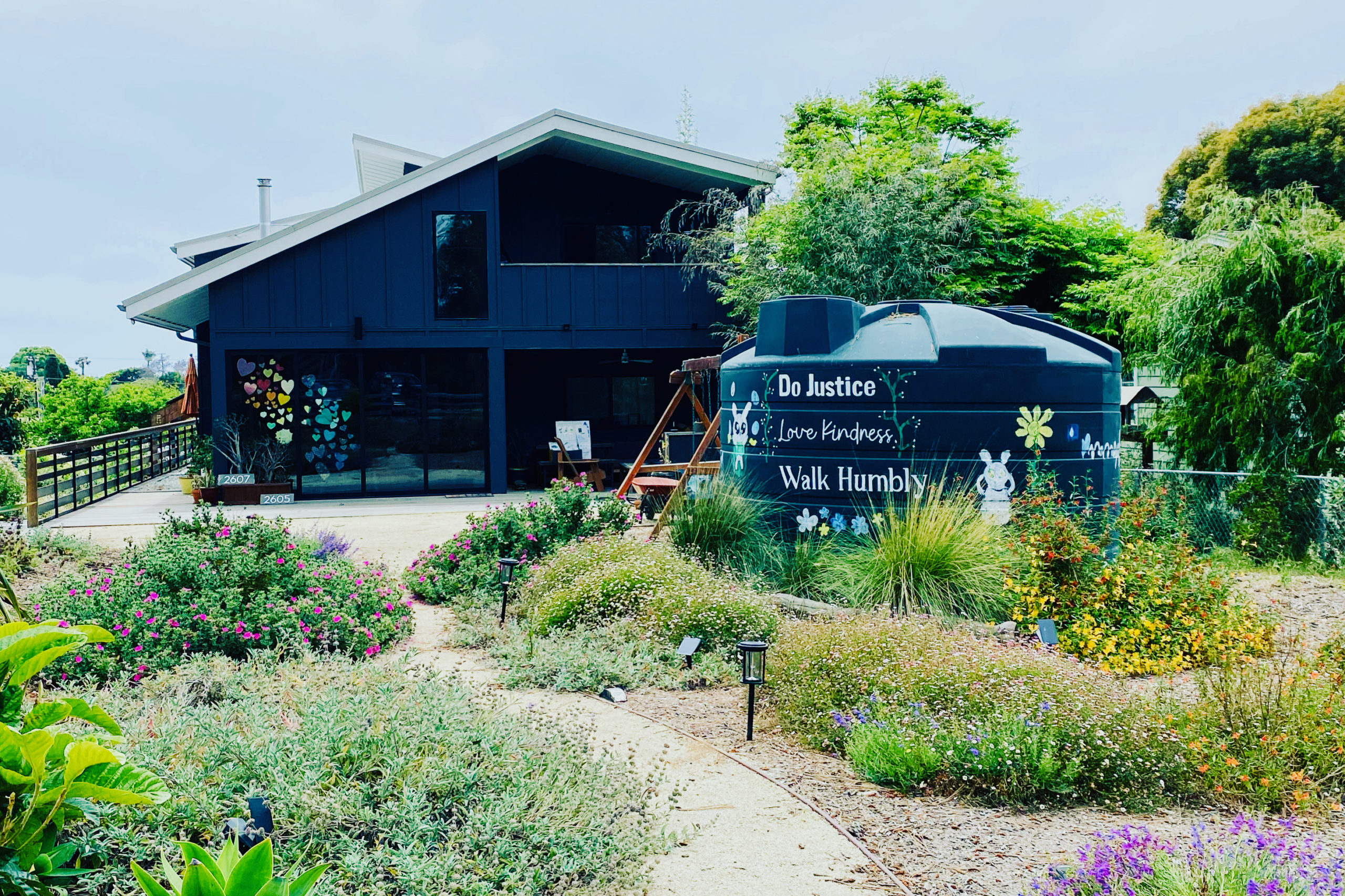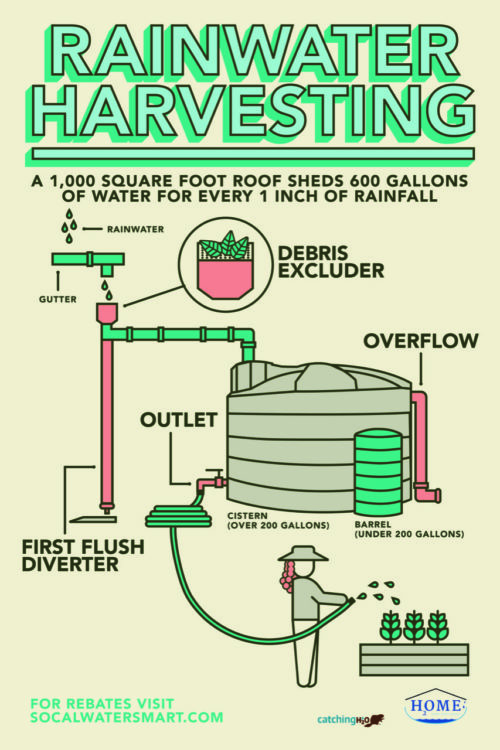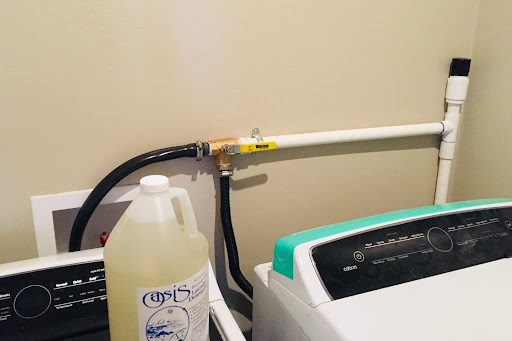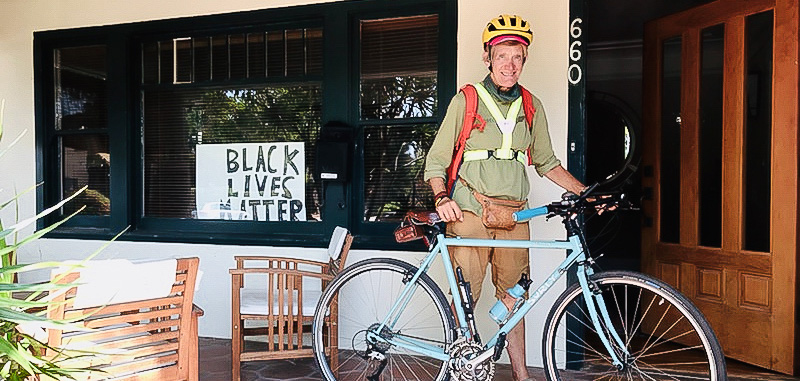What We Do
We are committed to helping our community advance our water conservation ethic
to better reflect our sense of place and create resilience for the people, animals,
and plants that live here!

CathchingH2O is laser focused on providing solutions to San Diego’s water supply, stormwater pollution, and wastewater management issues. As licensed contractors in the specialized industry of water harvesting and conservation, we are uniquely positioned to implement well designed decentralized solutions. We know individual contributions create tremendous impact toward a larger water conservation strategy. From DIY classes, to design/planning, to installation, CatchingH2O can help you conserve water, solve water related problems at your site, and contribute to larger scale solutions.
Why harvest Rainwater and Greywater?
- Save water and money
- Improve resilience to climate change
- Keep oceans and rivers clean
- Decrease pressure on municipal water treatment by diverting greywater
- Maximize plant and soil health
- Provide opportunity to grow food and other plants without reliance on municipal water
- Reduce dependence on energy intensive imported and highly processed water use for landscape irrigation
What is Active Rainwater Harvesting
Active Rainwater Harvesting means collecting rainwater in a tank or barrel. We install “cisterns”, which are containers larger than 200 gallons.
- Longevity: One reason for this is because we only install systems that will hold up over the years. The containers we use are UV rated to resist algae growth and not break down for 25 years. We paint all our above ground pipes to make sure they don’t break down over time due to the sun. Since we have been maintaining our systems for over 10 years, we know what works and what doesn’t and are always improving our materials and design to accommodate new information
- Flow Rate: The containers we use are able to capture a rain event coming from your downspout at a peak rate, and overflow that same amount at that same rate.
- Avoid flooding and expensive drainage systems: We design this to ensure that this water is routed to a safe place away from your home where it won’t cause problems for your neighbors, or erosion.
- Ease of use of stored water: We install our own hardware to ensure ease of use (high quality, large aperture spigots that enhance gravity flow).
- Maintenance ease: We ALWAYS filter the water before it gets into the tanks so that the water can be held in reserve for up to a year! And the maintenance on the external filters is easy.

- Above ground vs below ground: We primarily install above ground round plastic tanks for the simple reason that they are the most cost effective to buy, transport and to install. Did you know that you don’t need a permit to install a large plastic rainwater tank and there are no setback requirements since they are considered a moveable structure.
- Plastic vs Metal: We are distributors for and install CorGal corrugated steel tanks . We love these tanks because they are high quality and so versatile in size. Be aware that between materials, permitting, foundation, and installation these tanks can be 4-7 times the cost of round plastic tanks. The affordability starts to make more sense when you want to put in larger than 5,000 gallons.
- Distribution of your rainwater: Gravity is the most cost effective way to use your rainwater, but when you are storing a few thousand gallons of water, it may not be practical to flood irrigate your landscape. We offer a few different options for distribution:
- Gravity feed with a hose
- Gravity feed with a flood irrigation on timer (separate to your existing irrigation system - turn your system off when flood irrigating). This is low cost $150-$450
- Simple pump to 1-2 small irrigation zones, not tied in with larger system (ex. new veggie beds) $1500 - $2500 - we also have a DIY option for this which includes a parts list and instructions
- Selecting and sizing a pump to handle several irrigation zones tied into your main controller. This often involves electrical work and sometimes a new controller, as well as some work on your existing or new irrigation valves. $2500 - $4500

What is Passive Rainwater Harvesting

Passive Rainwater Harvesting is directing rainwater into earthworks, like basins and swales, to keep water out of storm drains and allow water to soak into your landscape. This means your plants’ roots will have access to accumulated moisture in the soil long after the rains cease. Also, whereas your landscape would receive whatever rain from the sky, when harvesting water from roofs and other impervious surfaces into the ground, you are compounding the amount of moisture available to your plants. For example a 500 square foot roof draining a 1” rainfall into a 500 square foot basin, means that basin receives 1” from the sky and another inch from your roof, doubling the amount of water you can capture for your plants.
Sculpting the land to hold water, using mulch where appropriate to encourage healthy soils, and adding plants whose roots pump the water from the soil as well as add to soil health and diversity in the environment are all elements of passive rainwater harvesting. Choosing plants that grow within your existing rainfall budget, like natives, means you are not using imported water to create a beautiful landscape. This sometimes takes the form of a rain garden.
What is Greywater Harvesting
While one size does not fit all, we can find an appropriate greywater recycling and reuse system for your home.
Greywater is the water from showers, bathroom sinks, and laundry machines, which can easily be reused in landscapes and gardening to help lower the use of city water or depleting wells. Surprisingly this can also mitigate septic tank management. But you don’t want to use greywater to water your lawn. Learn more about greywater myths here.
We have installed hundreds of greywater systems throughout Southern California as well as taught hundreds more how to install their own systems. We install systems that meet Chapter 15 of the California Plumbing Code as well as best practices, and ecological consideration. This means:
- Does not require a permit as long as the plumbing of the house is not modified
- A three way valve is installed which allows user to switch back to sewer/septic as needed
- System distribution area must be able to contain a peak laundry day
- No surface flow - all distribution must be in basins filled with mulch
- No leafy green vegetables or root vegetables
- Certain plants sensitive to salts will not be irrigated
- Setback rules for neighboring properties and public right of ways are considered

- California code requires permitting shower greater systems. Talk to us about options for non permitted systems.
- Is usually accessible through a crawlspace or from a ceiling or wall outside a second story shower. It is NOT accessible from a slab foundation, unless you are remodeling your bathroom.
- A three way valve is installed which allows user to switch back to sewer/septic as needed - a remote switch can be added for site appropriate access.
- The topography of your landscape will determine whether a pump is needed or we can use gravity
- No surface flow - all distribution must be in basins filled with mulch
- No leafy green vegetables or root vegetables
- Certain plants sensitive to salts will not be irrigated
- Because the daily volume of water can be large, a large area might be required for distribution, especially in high clay soils with low percolation rates.
- Setback rules for neighboring properties and public right of ways are considered

- Reserved usually for new construction
- Usually involves a pump for efficient and effective distribution
- Can manage large volumes of water effectively to grow a beautiful landscape
Policy and Broader Work
We are committed to not just creating a “sustainable product” but also performing all of our tasks in our business with the highest ecological considerations including:

- Partnering with other ecologically minded professionals to ensure your landscapes and other aspects of your project are given as much care and consideration as everything we do.
- Offering events that are low impact and highlight sustainability
- Working with policy makers and local sustainability nonprofits to educate and change policy around local decentralized water opportunities
- Relying on economy cars rather than a fleet of trucks
- Carpooling when possible
- Creating designs that are efficient, eliminating extra tanks, pumps, parts where possible.
- Minimizing waste through thoughtful ordering and careful installation practices
- Using high quality materials to ensure they are resilient throughout the years
Greywater and Rainwater Harvesting can help reverse climate change!
Integrated Regional Water Management (IRWM)
Brook is a member of SDIRWM Regional Advisory Committee. In her role she strives to better understand water policy in the region and speak up with other climate initiatives for localizing our water infrastructure and using the most ecological lens to analyze projects that the IRWM is funding.
Check out these important regional documents on the issues and challenges to a broader use of decentralized water systems in San Diego as well as proposed solutions that we created under the leadership of the Public Health Alliance of Southern California, and in partnership with UCSD.


